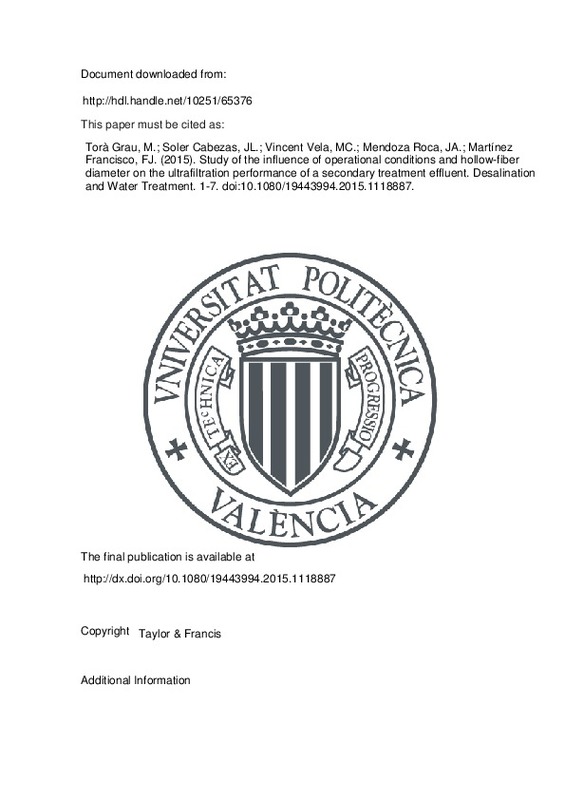JavaScript is disabled for your browser. Some features of this site may not work without it.
Buscar en RiuNet
Listar
Mi cuenta
Estadísticas
Ayuda RiuNet
Admin. UPV
Study of the influence of operational conditions and hollow-fiber diameter on the ultrafiltration performance of a secondary treatment effluent
Mostrar el registro sencillo del ítem
Ficheros en el ítem
| dc.contributor.author | Torà Grau, Miriam
|
es_ES |
| dc.contributor.author | Soler Cabezas, José Luis
|
es_ES |
| dc.contributor.author | Vincent Vela, Maria Cinta
|
es_ES |
| dc.contributor.author | Mendoza Roca, José Antonio
|
es_ES |
| dc.contributor.author | Martínez Francisco, Francisco Juan
|
es_ES |
| dc.date.accessioned | 2016-06-07T08:57:05Z | |
| dc.date.available | 2016-06-07T08:57:05Z | |
| dc.date.issued | 2015-11-26 | |
| dc.identifier.issn | 1944-3994 | |
| dc.identifier.uri | http://hdl.handle.net/10251/65376 | |
| dc.description.abstract | Secondary treatment effluents from municipal wastewater treatment plants (MWWTP) must achieve high water quality standards for their reuse in agriculture. To achieve these standards, ultrafiltration (UF) process, which is economically feasible, is carried out. However, UF has a drawback, membrane fouling, which causes operating difficulties and an increment of the operating cost. In order to minimize this phenomenon, it is important to determine the best operational conditions. Wastewater samples provided by MWWTP have a lot of variability in their composition due to factors such as temperature, efficiency of the secondary treatment, etc. Besides, the soluble microbial products of the secondary effluent are dependent on the type of the biological treatment implemented and its operating conditions. A model wastewater feed solution was prepared consisting of 15 mg/L of bovine serum albumin and 5.5 mg/L of dextran. In this research, UF tests were performed with the optimal simulated wastewater using two membranes UFCM5 Norit X-flow® hollow-fiber: one of them with a fiber diameter of 1.5 mm and the other one with a fiber diameter of 0.8 mm. The operational conditions, which influence membrane fouling, were varied in the range of 62 100 kPa for transmembrane pressure (TMP) and in the range of 0.8 1.2 m/s for cross-flow velocity (CFV). The best operational conditions were selected in terms of higher permeate flux. The highest permeate flux was obtained for the membrane of 0.8 mm and the lower energy consumption was achieved at a CFV of 1.2 m/s and a TMP of 62 kPa. | es_ES |
| dc.language | Inglés | es_ES |
| dc.publisher | Taylor & Francis | es_ES |
| dc.relation.ispartof | Desalination and Water Treatment | es_ES |
| dc.rights | Reserva de todos los derechos | es_ES |
| dc.subject | Ultrafiltration | es_ES |
| dc.subject | Hollow-fiber diameter | es_ES |
| dc.subject | Operational conditions | es_ES |
| dc.subject | Secondary treatment effluent | es_ES |
| dc.subject | Fouling | es_ES |
| dc.subject.classification | INGENIERIA QUIMICA | es_ES |
| dc.title | Study of the influence of operational conditions and hollow-fiber diameter on the ultrafiltration performance of a secondary treatment effluent | es_ES |
| dc.type | Artículo | es_ES |
| dc.identifier.doi | 10.1080/19443994.2015.1118887 | |
| dc.rights.accessRights | Abierto | es_ES |
| dc.contributor.affiliation | Universitat Politècnica de València. Departamento de Ingeniería Química y Nuclear - Departament d'Enginyeria Química i Nuclear | es_ES |
| dc.contributor.affiliation | Universitat Politècnica de València. Instituto de Seguridad Industrial, Radiofísica y Medioambiental - Institut de Seguretat Industrial, Radiofísica i Mediambiental | es_ES |
| dc.description.bibliographicCitation | Torà Grau, M.; Soler Cabezas, JL.; Vincent Vela, MC.; Mendoza Roca, JA.; Martínez Francisco, FJ. (2015). Study of the influence of operational conditions and hollow-fiber diameter on the ultrafiltration performance of a secondary treatment effluent. Desalination and Water Treatment. 1-7. doi:10.1080/19443994.2015.1118887 | es_ES |
| dc.description.accrualMethod | S | es_ES |
| dc.relation.publisherversion | http://dx.doi.org/10.1080/19443994.2015.1118887 | es_ES |
| dc.description.upvformatpinicio | 1 | es_ES |
| dc.description.upvformatpfin | 7 | es_ES |
| dc.type.version | info:eu-repo/semantics/publishedVersion | es_ES |
| dc.relation.senia | 299002 | es_ES |
| dc.identifier.eissn | 1944-3986 |







![[Cerrado]](/themes/UPV/images/candado.png)

